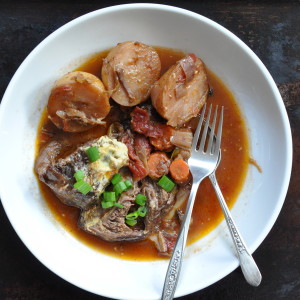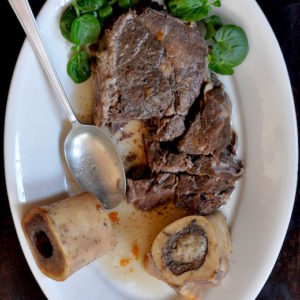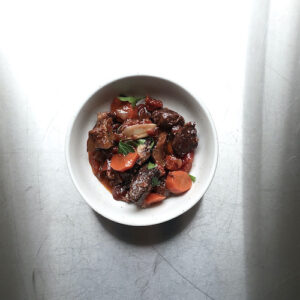Brasato after Judy Rodgers
10-7-16. I’d like to take an editorial moment here to thank a friend who notes that after all my hemming and hawing about the pig’s foot, below, I neglect to include it in the braise. Such are the perils of a one-woman show. I only wish I could pay him for his excellent eye. The post has been updated. My apologies to readers!
—
Here was a dish where nearly everything conspired against us: we bought the wrong cut of stewing beef. The weather seesawed from hot to cold to hot again: not really stew-eating weather. A host of extra-kitchen interruptions meant our intrepid hostess forgot to presalt said wrong cut of beef. In a final coup de grace, the possibility of oral surgery looms on the horizon, necessitating a brief absence from the IK and indeed, from solid food in general.
May we recommend Asian Noodle Soup? How about Chicken Broth? Of course, a stiff drink (or two, or three) is entirely in order, but that was true long before tooth #31 began kicking up.
—
Why “after” Judy Rodgers? Because the recipe, which appears in The Zuni Cafe Cookbook, isn’t followed to the letter. Given my oft-stated reverence for this book, it feels transgressive to blithely announce I had the wrong cut of beef, deglazed with a little Armagnac, and mashed the vegetables into the final sauce instead of pushing them through a sieve.

Then again, Rodgers writes her hugely instructive introduction, “Recipes do not make food taste good; people do.” She is discussing cultivating the habit of tasting while cooking. But her words are just as applicable to the idea that recipes–within reason, of course–are living, breathing entities. No, I didn’t have the whole beef shoulder specified. I did have grass-fed stew beef, sliced from a whole chuck roast. I knew this because the butcher had pointed to the chuck as I dithered over which cut to buy. “Same thing,” she said. “Already cut.”

Reality is about making dinner when you have same thing, already cut. And this blog is about working with what you’ve got, not training for the competitive dinner party circuit. Stew beef? Bottle of red wine? Onions? Carrots? Optional pork product? Optional French brandy? Yes to all of the above?

Let’s braise.
—
Well, one sec..
What is this thing called Brasato?
After spending two hours leafing through my cookbooks, attempting to define terms, let us say brasato is Italian for the French braise, meaning “to cook in the coals.”
That is, place a tough, cartilaginous cut of animal protein in a sealed pot with some root vegetables, aromatics, and a little liquid. After the pot is tucked into the embers, pile hot coals on top for good measure. Cook for 8 or 10 or 15 hours while you harvest crops or card wool or chop wood.
In the days before central heating, home ovens, and the general heating up of our planet, braising wasn’t about off-the-grid-living for dissatisfied couples with dual MBA’s and babies with names like Juniper. Braises were about taking inedible proteins and making them not only digestible, but delicious. So even as fireplaces gave way to central heating and ovens, braising stuck around.

“Braise” may also encompass the cooking vessel, as in braiser. The braiser as cooking vessel may be found in mail-order catalogs of a certain type, mailed to people of a certain demographic. These attractive pots are available in a range of colors, sizes, and price points. Said price points skew ever upward.
Anyway.
This definition is far from comprehensive. A brief list of suggested further reading and cooking:
Marcella Hazan: Essentials of Italian Cooking
Elisabeth Luard: The Old World Kitchen
Molly Stevens: All About Braising
Paula Wolfert: The Cooking Of Southwest France
—
Some pre-recipe throat clearing:
Braises are built, not tossed together. I mean, you can toss this together, and it will taste that way. So know this recipe takes a little time up front. But most of that time isn’t very active on your part, unless you’re the type who needs to watch wine as it reduces.

Rodgers calls for a pig foot in her recipe. Many old French recipes do; pig’s feet, also called trotters, add body to sauces and stews. They are available in larger markets, often sold in sets; the ones I buy are sold bandsawed in half. Provided you wrap them well in foil, pig feet freeze beautifully. Mine have kept for over a year in the freezer.

Although I don’t keep kosher, pig’s feet represented a final cooking frontier. I mean, pig’s feet. Right?
But here I was, happily eating pork chops and cooking with all sorts of other porky cuts. Meanwhile, people like Fergus Henderson and Jennifer McLagan and Anthony Bourdain were telling me to use the whole animal. And authors I deeply respect, like Judy Rodgers, Paula Wolfert, and David Tanis, were all cooking with pig feet. It felt hypocritical for me to be squeamish.
This said, if you prefer not to use pig feet, the brasato will be fine without them.

Brasato After Judy Rodgers
Adapted from The Zuni Cafe Cookbook by Judy Rodgers
Preparation time:
1 hour-3 days for presalting meat; an optional but delicious step
approximately 1 hour to reduce wine and prepare the braise
2-3 hours braising time in oven
Yield: 2-6 servings; see ingredient list
1-4 pounds beef stewing meat sliced into chunks; See notes for discussion of cuts and serving amounts
Kosher or fine sea salt
1 bottle decent, hearty red wine: Merlot, Syrah, Cabernet Sauvignon
2 cups unsalted chicken stock
1 pig’s foot (optional)
about 1 tablespoon olive oil, for browning the beef
optional: shot of Armagnac or brandy for deglazing the pan
1 large carrot, peeled and chunked
1 medium yellow onion, peeled and cut into wedges
optional: celery root, peeled and chunked (omitted here as John dislikes celery root)
10-14 whole unpeeled garlic cloves
1 bay leaf
10-12 black peppercorns, lightly cracked
Presalt the beef:
One hour to three days ahead of cooking: Use a scant teaspoon of kosher or fine sea salt per pound of meat, seasoning evenly all over. Cover and refrigerate beef until use.
One hour before putting the braise into the oven, take meat out of refrigerator.
Pour the bottle of wine into a pot that will hold it. Turn the burner to medium high and reduce the wine to a half-cup. A splatter screen is useful here.
Reducing the wine takes 45 minutes to an hour; while it reduces, prepare the rest of the braise.
Turn the oven to 325 F/160C
If you are using the pig’s foot, place it in a small pot–about 2 quarts/liters works well–and cover it with cold water. Bring the pot of water to a boil, skim, and reduce to a simmer. Simmer for about 20 minutes. Drain the pig’s foot and set aside to cool.
Brown the beef: pour the olive oil into a sauté pan. If you have not pre-salted the beef, salt it lightly now, using about a teaspoon of kosher or fine sea salt per pound-or to taste. Brown the meat lightly, in batches if necessary. Do not crowd the pan, as meat will steam rather than brown if crowded. The meat doesn’t need to be perfectly browned on all sides. You just want some nice color on it.
Remove the beef to a plate as you go, or, if you prefer, remove it to your braising vessel. I use a Staub 4-quart/liter “Everyday” pan for braising, which must be heated slowly. So I put it on a low burner while browning, transferring the beef as I go.
To assemble the braise:
Place the browned beef in the center of a 4-6 quart/liter heavy casserole or Dutch oven, ideally with a lid. You want the cooking vessel to just hold the quantity of food you’re braising. Surround the beef with the carrot, onion, celery root, if using, the pig’s foot, and the garlic cloves. Sprinkle the peppercorns into the pan. Add the bay leaf.
I deglazed the sauté pan with a generous shot of Armagnac, scraping the fond with a spatula, tipping the small amount of liquid into the braising pot.
Pour in chicken broth so it’s about one inch/4 cm up the sides of the pot. Judy Rodgers notes that you may not use all the stock at first, but should save it in case you need it later.
Add the wine, which will be very dark.
Cover the pot with a lid, or seal tightly with foil if you don’t have a lid. Place in the oven.
Cook, checking at the hour point and turning the meat gently, if necessary. Braise will be fork-tender between 2-3 hours, depending on your oven, cooking vessel, and the meat you are using.
I started my braise at 325/160 degrees at noon. At 1:00, the stew was bubbling so strongly that I turned the oven down to 300/150. By 2:30 the meat was fork-tender.
Much of this is experience and knowing your oven. You won’t go wrong at 300/150 or 325/160 degrees provided you use your senses: your nose and tastebuds will tell you.
To finish the braise:
While you can serve the braise immediately, all stews benefit from an overnight rest in the refrigerator.
Do allow the braise to cool slightly. Taste a spoonful of sauce: it may need salt, a bit of sugar, or perhaps some balsamic vinegar. You may want to add a little broth to extend it. Or it may be fine as is. If you are unsure, pour a little sauce into a small bowl. That way you are tweaking a small taste rather than the entire potful.
Once the sauce is to your liking, you can remove the meat and push the vegetables through a sieve or food mill for a silken puree. Or, as I did, you can peel the garlic by hand, gently mash the carrots with a potato masher, and leave it at that. Or you can serve everything as is, leaving the garlic to your dining companions.
If you have included a pig’s foot, you can shred the meat and include in the dish, though the ones I purchase tend to be so bony that I discard them after cooking.
Serve with polenta, mashed potatoes, couscous, or rice. A green salad and bread are necessary accompaniments Chez IK.
Brasato improves over about five days in the refrigerator. Freezing is inadvisable as the stew will become tasteless mush.
Lunch note: you know those terribly unhealthy hot dog buns? The white bread ones we’re not supposed to eat anymore? That we don’t have in our freezers? Spread one with mayo and sharp mustard. Now put lettuce and red onion on it (we’re making up for the buns here) Now add some leftover beef and some of the gungy, half-heated sauce. Close bun. Add some potato chips we all pretend we never, ever eat.
Notes: You can purchase a whole chuck roast and cut it yourself, or buy stewing beef. I bought 1.5 pounds organic grass fed chuck, (about 600 grams) which fed 2 modest eaters with leftovers. Three to four pounds will feed 4-6 people generously with leftovers. Do buy the best meat you can afford.





